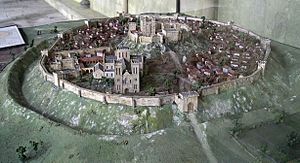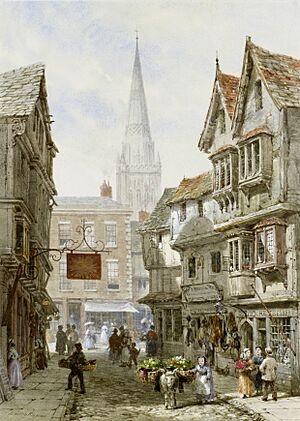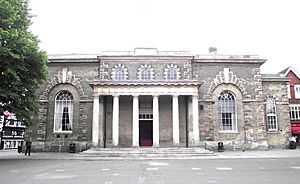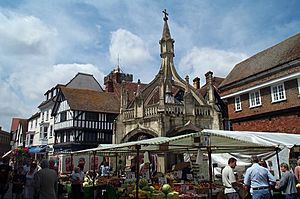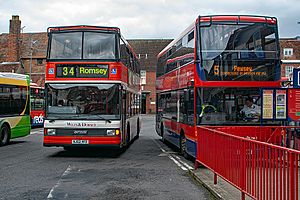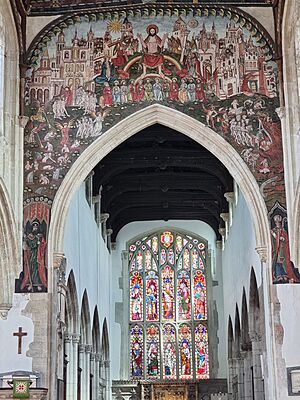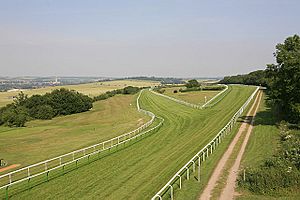Salisbury facts for kids
Quick facts for kids Salisbury |
|
|---|---|
| City | |
 Salisbury Cathedral from the Old George Mall in July 2016 |
|
| Population | 41,820 (2021 Census) |
| OS grid reference | SU145305 |
| • London | 78 miles (126 km) |
| Civil parish |
|
| Unitary authority |
|
| Ceremonial county | |
| Region | |
| Country | England |
| Sovereign state | United Kingdom |
| Post town | SALISBURY |
| Postcode district | SP1, SP2 |
| Dialling code | 01722 |
| Police | Wiltshire |
| Fire | Wiltshire |
| Ambulance | Great Western |
| EU Parliament | South West England |
| UK Parliament |
|
Salisbury is a historic city in Wiltshire, England. It is known for its beautiful Salisbury Cathedral and its rich past. About 41,820 people live here, based on the 2021 Census. The city is located where three rivers meet: the Avon, Nadder, and Bourne.
Salisbury is in the southeast of Wiltshire, close to Salisbury Plain. Long ago, a very old cathedral stood north of the current city at a place called Old Sarum. A new cathedral was built near the rivers, and a town grew up around it. This new town officially became a city in 1227 and was called New Sarum. This name was used until 2009. Salisbury is also a key travel hub, with Salisbury railway station connecting major train lines.
Just 8 miles (13 km) northwest of Salisbury is Stonehenge, a famous ancient monument and a UNESCO World Heritage Site.
Contents
- What's in a Name?
- Salisbury's Story
- How Salisbury is Governed
- Salisbury's Location
- People of Salisbury
- Salisbury's Economy
- Culture and Arts
- Sister Cities
- Learning in Salisbury
- Getting Around Salisbury
- Churches in Salisbury
- Sports and Fun
- Famous People from Salisbury
- Media in Salisbury
- Salisbury's Weather
- City Honors
- Images for kids
- See also
What's in a Name?
The name Salisbury comes from an old name, Searoburg, first written around the year 900. This was partly translated from an even older Roman Celtic name, Sorbiodūnum. The old word -dūnon meant "fortress," referring to the fort at Old Sarum. This was replaced by the Old English word -burg, which also means "fortress" or "town."
The shorter name "Sarum" is a Latin version of Sar, a medieval way to shorten Sarisberie.
Salisbury's Story
Old Sarum: The First Settlement
The hilltop of Old Sarum is very old, close to the famous Stonehenge. People lived there a long time ago, even in the Stone Age. It was a great spot between two rivers, the Bourne and the Hampshire Avon. Many early trade routes crossed nearby.
Around 600 to 300 BC, during the Iron Age, a hillfort was built there. Later, the Romans might have used the site. When the Saxons arrived, King Cynric of Wessex took Old Sarum in 552. The Saxons preferred towns in valleys, so Old Sarum was mostly left alone until the Vikings attacked.
King Alfred the Great (who ruled from 871 to 899) rebuilt its defenses. However, in 1003, the Danish-Norwegian king Sweyn Forkbeard attacked and burned it. After the Normans took over England in 1066, they built a motte-and-bailey castle by 1070. This castle was directly controlled by the Norman kings.
In 1075, Herman became the first bishop of Salisbury. He started building the first Salisbury cathedral, which was finished in 1092. His successor, Saint Osmund, helped create the Domesday Book. The cathedral was damaged by a storm soon after it was built.
Bishop Roger was a close friend of King Henry I. He improved Old Sarum's cathedral and started building a royal palace in the 1130s. However, after he was arrested by King Stephen, the castle began to fall apart.
New Sarum: The City We Know Today

The bishops of Salisbury, Herbert and Richard Poore, decided to move the cathedral to a new location in the valley. Their plans were approved by King Richard I. One reason for the move was that the church leaders and the castle guards at Old Sarum didn't get along. The church was described as "a captive within the walls of the citadel."
So, in 1220, Bishop Richard Poore moved the cathedral to a new spot. This new place was a meadow called "Myrifield," near where the River Nadder and Hampshire Avon meet. It was first called "New Sarum." The town was planned with a grid of streets.
Building the new Salisbury Cathedral began in 1221. Legend says the spot was chosen by shooting an arrow from Old Sarum. However, this is likely just a story, as the distance is too far. The main part of the cathedral was finished in just 38 years. The tall spire, which is 123 meters (404 ft) high, was added later and is the tallest in the UK. Many stones for the new cathedral came from the old one at Old Sarum. The cathedral is a great example of Early English architecture. It also has a very old clock, installed in 1386, and one of the best-preserved copies of Magna Carta.
New Sarum officially became a city in 1227 by a charter from King Henry III. By the 14th century, it was the biggest town in Wiltshire. A city wall was built around the cathedral area, also using stones from Old Sarum. This wall has five gates, most of which are original. The old site at Old Sarum slowly became unused.
In 1289, a meeting at Salisbury led to the Treaty of Salisbury. This agreement was about the future of Margaret, the Maid of Norway. The Parliament of England also met in New Sarum several times in the 1300s.
In 1450, there were riots in Salisbury, partly due to problems with the city's cloth trade. The bishop, William Ayscough, was even killed. In 1483, a rebellion against King Richard III failed, and its leader, the Duke of Buckingham, was executed in Salisbury. In 1664, the River Avon was made suitable for boats, but a big flood soon ruined the project. Later, during the Great Plague of London, King Charles II held court in Salisbury.
In 1688, King James II gathered his army in Salisbury to fight against the Glorious Revolution. But his soldiers were not eager to fight, and many of his commanders left him. King James returned to London, never again leading a serious army in England.
Salisbury in the 20th and 21st Centuries
During World War II, after factories in Southampton were bombed, Supermarine Spitfire planes were secretly built in Salisbury. Young women, with no prior experience, were trained to build parts of the planes. These parts were then taken to airfields nearby to be put together and flown. Over 2,000 Spitfires were made in secret. In 2021, a memorial was put up in Salisbury to honor these workers.
In 1948, when the 1948 Summer Olympics were held in London, the Olympic Flame passed through Salisbury on its way to the sailing events.
The city's official name changed from "New Sarum" to "Salisbury" in 2009.
On March 4, 2018, a former Russian double agent, Sergei Skripal, and his daughter were affected by a nerve agent in Salisbury.
How Salisbury is Governed
Salisbury is part of Wiltshire county. It is managed by the Wiltshire Council. Salisbury also has its own local council called the Salisbury City Council.
The city is divided into different areas for local elections. The Member of Parliament (MP) for Salisbury, which includes the city and nearby areas, is John Glen. He is from the Conservative Party and was first elected in 2010.
Salisbury's Location
Salisbury is about halfway between Exeter and London. It is 78 miles (126 km) west-southwest of London. It is also 20 miles (32 km) northwest of Southampton and 32 miles (51 km) southeast of Bath.
The land around Salisbury is mostly chalk. The rivers that flow through the city have been changed to create beautiful public gardens. These gardens, like Queen Elizabeth Gardens, are popular in summer. However, because the land is low, the rivers can flood, especially in winter.
There are small airfields at Old Sarum and Thruxton.
Areas and Neighborhoods
Salisbury has many neighborhoods, which were once separate villages. These areas include:
- Bemerton
- Lower Bemerton
- Bemerton Heath
- Hampton Park
- City Centre
- Churchfields
- East Harnham
- West Harnham
- Harnham Hill
- Stratford-sub-Castle
- St Paul's
- St Francis
- Fisherton
- St Mark's
- Bishopdown
- Milford
- St Edmund
- Petersfinger
- Paul's Dene
- Friary Estate
- St Martin's
Many nearby villages and towns also rely on Salisbury for services. Some of these are:
- Britford
- Odstock
- Quidhampton
- Nunton
- Homington
- Old Sarum
- Little Durnford
- Fugglestone St Peter
- Alderbury
- Bodenham
- Downton
- Wilton
- Charlton All Saints
- Ditchampton
- Bulbridge
- Coombe Bissett
- Ugford
- South Newton
- Winterbourne Earls
- Winterbourne Gunner
- Winterbourne Dauntsey
People of Salisbury
In 2011, the population of Salisbury's main area was 40,302. Most people (91%) were White British. The largest minority group was 'other white' (3.6%).
Most people (86.43%) were born in England. About 62.49% of people said their religion was Christianity, while 27.09% said they had no religion. English was the main language for 95.89% of the population.
Salisbury's Economy
Salisbury has a market on Tuesdays and Saturdays, which has been held regularly since 1227. In the 15th century, the Market Place had four crosses marking different market sections. Today, only the Poultry Cross remains.
Since 1226, the Bishop of Salisbury has had permission to hold a fair. Today, a funfair is held in the Market Place for three days in October.
From 1833 to the 1980s, the Salisbury Gas Light and Coke Company was a major employer. It produced gas and other products like coke and fertilizer. Salisbury was also known for its cutlery industry for many centuries. Early cars were made in the city from 1902 by Scout Motors.
Today, shopping centers like The Old George Mall and The Maltings are important. Salisbury District Hospital is a major employer.
Culture and Arts
Salisbury was a big music center in the 1700s. Famous musicians performed at the Assembly Rooms.
The city has an annual St George's Day pageant, which is said to have started in the 13th century.
Salisbury has a lively arts scene with many galleries. The Young Gallery is in Salisbury Library. The famous painter John Constable created many paintings of Salisbury Cathedral. The city also hosts an International Arts Festival each year, featuring theatre, music, dance, and art. Salisbury Playhouse is a theatre that produces its own plays.
The Salisbury Museum
The Salisbury Museum is in the King's House, a historic building across from the cathedral.
It has an exhibition about Stonehenge and the history of south Wiltshire. You can see the skeleton of the Amesbury Archer there. The museum also has a collection from General Augustus Pitt Rivers and a costume gallery where children can try on historical clothes.
The former home of Sir Edward Heath, a former Prime Minister, called Arundells, is also open as a museum in the Cathedral Close.
Sister Cities
Salisbury is twinned with:
It is also a sister city to:
- Salisbury, North Carolina, USA
- Salisbury, Maryland, USA
Learning in Salisbury
In the 13th and 14th centuries, Salisbury was a place of learning. The College of the Valley Scholars, founded in 1262, taught theology and liberal arts. Some say it was one of England's first university colleges.
Today, Salisbury has several schools. It has the only grammar schools in Wiltshire: South Wilts Grammar School for girls and Bishop Wordsworth's School for boys. Both schools now have mixed sixth forms (for older students). Other schools include Salisbury Cathedral School, Chafyn Grove School, and Sarum Academy.
Salisbury Sixth Form College offers education for students aged 16-18. Wiltshire College in Salisbury provides further education courses. Sarum College is a Christian college within the Cathedral Close.
Getting Around Salisbury
Roads
Salisbury is connected by several main roads, including the A30, A36, and A338. The A36 forms a ring road around the city center.
Buses
Bus services connect Salisbury to nearby towns like Southampton, Bournemouth, and Andover. Salisbury Reds is the main local bus company.
Salisbury has a Park and Ride system with five sites around the city. This helps reduce traffic in the city center. The old Salisbury bus station closed in 2014.
Trains
Salisbury railway station is an important train hub. It connects the West of England Main Line (from London Waterloo to Exeter) and the Wessex Main Line (from Bristol to Southampton). South Western Railway operates trains here. Great Western Railway also runs hourly trains.
Churches in Salisbury
Besides the famous Salisbury Cathedral, the city has many other churches. Three of them – St Martin, St Thomas, and St Lawrence – are very old and important.
Medieval Churches
St Martin's Church is older than the new cathedral. It has parts from the 1200s and 1400s.
St Edmund's was founded in 1269. It was damaged when its central tower fell in 1653. The church closed in 1974 and reopened as the Salisbury Arts Centre in 1975.
St Thomas' church is in the city center. It was built in the early 1200s and rebuilt in the 1400s by rich merchants. It has a large 15th-century painting called a "doom painting."
Other old churches include St George's at West Harnham (from the 12th century) and St Lawrence, Stratford-sub-Castle (from the 13th century). The small St Andrew church at Bemerton (14th century) is linked to the poet George Herbert.
19th and 20th Century Churches
St Osmund's (Catholic) was designed by Augustus Pugin and opened in 1848.
St Paul's church was built in 1853. All Saints' church was built in East Harnham in 1854. St John's church was built in Bemerton in 1861 and is now a community center. St Mark's was started in 1894 to serve the growing northern areas.
In the 20th century, St Francis's church was built in 1940 to serve the expanding suburbs.
Sports and Fun
The city has a football team, Salisbury F.C., who play at the Raymond McEnhill Stadium. Other local football clubs are Bemerton Heath Harlequins F.C. and Laverstock & Ford F.C..
Salisbury Rugby Club plays at Castle Road. South Wilts Cricket Club and Salisbury Hockey Club are based at the Salisbury and South Wiltshire Sports Club.
The Five Rivers Leisure Centre and Swimming Pool opened in 2002. Salisbury Racecourse is a horse racing track southwest of the city.
Old Sarum Airfield is home to flying schools and a charity for disabled flyers.
The city's theatre is the Salisbury Playhouse. The City Hall hosts comedy, music, and events. Salisbury Arts Centre, located in an old church, has exhibitions and workshops.
Salisbury has many pubs. The Haunch of Venison is in a 14th-century building. The Rai d'Or pub has original papers from 1292.
Famous People from Salisbury
Born Before 1900
- John of Salisbury (c. 1120–1180), a writer and bishop, born in Salisbury.
- Simon Forman (1552–1611), an astrologer and herbalist.
- John Bevis (1695–1771), an astronomer who discovered the Crab Nebula.
- James Harris (1709–1780), a politician and grammarian.
- Henry Fawcett (1833–1884), an economist and statesman.
- John Neville Keynes (1852–1949), an economist and father of John Maynard Keynes.
- Herbert Ponting (1870–1935), a photographer for Robert Falcon Scott's expedition to the South Pole.
- Lieutenant Colonel Tom Edwin Adlam (1893–1975), a brave soldier who received the Victoria Cross.
Born Since 1900
- William Golding (1911–1993), a famous novelist who taught in Salisbury.
- Iona Brown (1941–2004), a violinist and conductor.
- Michael Crawford (born 1942), an actor and singer, known for The Phantom of the Opera.
- John Rhys-Davies (born 1944), an actor known for playing Gimli in The Lord of the Rings.
- Anthony Daniels (born 1946), an actor known for playing C-3PO in Star Wars.
- David Mitchell (born 1974), a comedian and actor.
- Joseph Fiennes (born 1970), a film and stage actor.
Media in Salisbury
BBC Radio Wiltshire is the local radio station for the county. Salisbury used to have its own station, Spire FM, which is now Greatest Hits Radio Salisbury.
Local TV news is provided by BBC South and ITV Meridian. There is also a local TV channel called "That's Salisbury."
The Salisbury Journal is the local paid newspaper, available every Thursday. The Avon Advertiser is a free weekly newspaper delivered to homes.
Salisbury's Weather
Salisbury has a mild oceanic climate, like most of the UK. It is one of the sunniest inland areas in the UK, with over 1650 hours of sunshine each year. Temperatures have ranged from -12.4°C (9.7°F) in January 1963 to 34.5°C (94.1°F) in July 2006.
| Climate data for Boscombe Down, elevation: 128 m (420 ft), 1981–2010 normals, extremes 1960–present | |||||||||||||
|---|---|---|---|---|---|---|---|---|---|---|---|---|---|
| Month | Jan | Feb | Mar | Apr | May | Jun | Jul | Aug | Sep | Oct | Nov | Dec | Year |
| Record high °C (°F) | 13.6 (56.5) |
17.5 (63.5) |
21.3 (70.3) |
25.9 (78.6) |
27.5 (81.5) |
33.7 (92.7) |
34.5 (94.1) |
34.2 (93.6) |
28.7 (83.7) |
26.2 (79.2) |
17.6 (63.7) |
14.6 (58.3) |
34.5 (94.1) |
| Mean daily maximum °C (°F) | 7.2 (45.0) |
7.5 (45.5) |
10.3 (50.5) |
13.1 (55.6) |
16.6 (61.9) |
19.5 (67.1) |
21.9 (71.4) |
21.6 (70.9) |
18.6 (65.5) |
14.4 (57.9) |
10.3 (50.5) |
7.5 (45.5) |
14.1 (57.4) |
| Daily mean °C (°F) | 4.3 (39.7) |
4.3 (39.7) |
6.6 (43.9) |
8.6 (47.5) |
11.9 (53.4) |
14.7 (58.5) |
16.9 (62.4) |
16.8 (62.2) |
14.3 (57.7) |
10.9 (51.6) |
7.1 (44.8) |
4.6 (40.3) |
10.1 (50.2) |
| Mean daily minimum °C (°F) | 1.4 (34.5) |
1.1 (34.0) |
2.8 (37.0) |
4.1 (39.4) |
7.3 (45.1) |
9.9 (49.8) |
12.0 (53.6) |
12.0 (53.6) |
10.0 (50.0) |
7.3 (45.1) |
3.9 (39.0) |
1.8 (35.2) |
6.2 (43.2) |
| Record low °C (°F) | −12.4 (9.7) |
−9.6 (14.7) |
−9.6 (14.7) |
−4.7 (23.5) |
−2.4 (27.7) |
−0.1 (31.8) |
4.4 (39.9) |
3.6 (38.5) |
−0.1 (31.8) |
−3.4 (25.9) |
−6.4 (20.5) |
−11.3 (11.7) |
−12.4 (9.7) |
| Average precipitation mm (inches) | 74.5 (2.93) |
52.0 (2.05) |
57.2 (2.25) |
51.4 (2.02) |
54.4 (2.14) |
51.0 (2.01) |
48.9 (1.93) |
51.5 (2.03) |
59.4 (2.34) |
82.6 (3.25) |
84.0 (3.31) |
81.7 (3.22) |
748.6 (29.47) |
| Average precipitation days (≥ 1.0 mm) | 12.0 | 9.5 | 10.6 | 9.6 | 9.4 | 8.9 | 8.5 | 8.7 | 9.0 | 11.8 | 11.9 | 11.9 | 122.0 |
| Mean monthly sunshine hours | 62.2 | 80.8 | 119.2 | 175.0 | 205.9 | 217.7 | 223.3 | 205.3 | 152.3 | 114.9 | 75.1 | 57.8 | 1,689.4 |
| Source 1: Met Office | |||||||||||||
| Source 2: KNMI | |||||||||||||
City Honors
The city of Salisbury has given special honors, called the Freedom of the City, to certain people and military groups.
Individuals Honored
Military Units Honored
- The Royal Wiltshire Yeomanry: 1944.
- Royal Gloucestershire, Berkshire and Wiltshire Regiment: October 2004.
- The Rifles: 20 November 2010.
- 32nd Regiment, Royal Artillery: 7 July 2016.
- The Royal Military Police: 13 June 2018.
Images for kids
See also
 In Spanish: Salisbury para niños
In Spanish: Salisbury para niños



